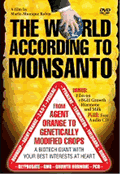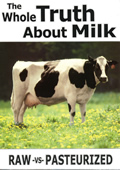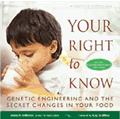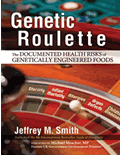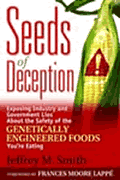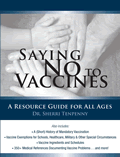DOCTORS WARN: AVOID GENETICALLY MODIFIED FOODS
By
Jeffrey Smith
May 30, 2009
NewsWithViews.com
On May 19th, the American Academy of Environmental Medicine (AAEM) called on “Physicians to educate their patients, the medical community, and the public to avoid GM (genetically modified) foods when possible and provide educational materials concerning GM foods and health risks.”[1] They called for a moratorium on GM foods, long-term independent studies, and labeling. AAEM’s position paper stated, “Several animal studies indicate serious health risks associated with GM food,” including infertility, immune problems, accelerated aging, insulin regulation, and changes in major organs and the gastrointestinal system. They conclude, “There is more than a casual association between GM foods and adverse health effects. There is causation,” as defined by recognized scientific criteria. “The strength of association and consistency between GM foods and disease is confirmed in several animal studies.”
More and more doctors are already prescribing GM-free diets. Dr. Amy Dean, a Michigan internal medicine specialist, and board member of AAEM says, “I strongly recommend patients eat strictly non-genetically modified foods.” Ohio allergist Dr. John Boyles says “I used to test for soy allergies all the time, but now that soy is genetically engineered, it is so dangerous that I tell people never to eat it.”
Dr. Jennifer Armstrong, President of AAEM, says, “Physicians are probably seeing the effects in their patients, but need to know how to ask the right questions.” World renowned biologist Pushpa M. Bhargava goes one step further. After reviewing more than 600 scientific journals, he concludes that genetically modified organisms (GMOs) are a major contributor to the sharply deteriorating health of Americans.
Pregnant women and babies at great risk
Among the population, biologist David Schubert of the Salk Institute warns that “children are the most likely to be adversely effected by toxins and other dietary problems” related to GM foods. He says without adequate studies, the children become “the experimental animals.”[2]
The experience of actual GM-fed experimental animals is scary. When GM soy was fed to female rats, most of their babies died within three weeks—compared to a 10% death rate among the control group fed natural soy.[3] The GM-fed babies were also smaller, and later had problems getting pregnant.[4]
When male rats were fed GM soy, their testicles actually changed color—from the normal pink to dark blue.[5] Mice fed GM soy had altered young sperm.[6] Even the embryos of GM fed parent mice had significant changes in their DNA.[7] Mice fed GM corn in an Austrian government study had fewer babies, which were also smaller than normal.[8]
Reproductive problems also plague livestock. Investigations in the state of Haryana, India revealed that most buffalo that ate GM cottonseed had complications such as premature deliveries, abortions, infertility, and prolapsed uteruses. Many calves died. In the US, about two dozen farmers reported thousands of pigs became sterile after consuming certain GM corn varieties. Some had false pregnancies; others gave birth to bags of water. Cows and bulls also became infertile when fed the same corn.[9]
In the US population, the incidence of low birth weight babies, infertility, and infant mortality are all escalating.
Food designed to produce toxin
GM corn and cotton are engineered to produce their own built-in pesticide in every cell. When bugs bite the plant, the poison splits open their stomach and kills them. Biotech companies claim that the pesticide, called Bt—produced from soil bacteria Bacillus thuringiensis—has a history of safe use, since organic farmers and others use Bt bacteria spray for natural insect control. Genetic engineers insert Bt genes into corn and cotton, so the plants do the killing.
The Bt-toxin produced in GM plants, however, is thousands of times more concentrated than natural Bt spray, is designed to be more toxic,[10] has properties of an allergen, and unlike the spray, cannot be washed off the plant.
Moreover, studies confirm that even the less toxic natural bacterial spray is harmful. When dispersed by plane to kill gypsy moths in the Pacific Northwest, about 500 people reported allergy or flu-like symptoms. Some had to go to the emergency room.[11], [12]
The exact same symptoms are now being reported by farm workers throughout India, from handling Bt cotton.[13] In 2008, based on medical records, the Sunday India reported, “Victims of itching have increased massively this year . . . related to BT cotton farming.”[14]
GMOs provoke immune reactions
AAEM states, “Multiple animal studies show significant immune dysregulation,” including increase in cytokines, which are “associated with asthma, allergy, and inflammation”—all on the rise in the US.
According to GM food safety expert Dr. Arpad Pusztai, changes in the immune status of GM animals are “a consistent feature of all the studies.”[15] Even Monsanto’s own research showed significant immune system changes in rats fed Bt corn.[16] A November 2008 by the Italian government also found that mice have an immune reaction to Bt corn.[17]
GM soy and corn each contain two new proteins with allergenic properties,[18] GM soy has up to seven times more trypsin inhibitor—a known soy allergen,[19] and skin prick tests show some people react to GM, but not to non-GM soy.[20] Soon after GM soy was introduced to the UK, soy allergies skyrocketed by 50%. Perhaps the US epidemic of food allergies and asthma is a casualty of genetic manipulation.
Animals dying in large numbers
In India, animals graze on cotton plants after harvest. But when shepherds let sheep graze on Bt cotton plants, thousands died. Post mortems showed severe irritation and black patches in both intestines and liver (as well as enlarged bile ducts). Investigators said preliminary evidence “strongly suggests that the sheep mortality was due to a toxin. . . . most probably Bt-toxin.”[21] In a small follow-up feeding study by the Deccan Development Society, all sheep fed Bt cotton plants died within 30 days; those that grazed on natural cotton plants remained healthy.
In a small village in Andhra Pradesh, buffalo grazed on cotton plants for eight years without incident. On January 3rd, 2008, the buffalo grazed on Bt cotton plants for the first time. All 13 were sick the next day; all died within 3 days.[22]
Bt corn was also implicated in the deaths of cows in Germany, and horses, water buffaloes, and chickens in The Philippines.[23]
In lab studies, twice the number of chickens fed Liberty Link corn died; 7 of 20 rats fed a GM tomato developed bleeding stomachs; another 7 of 40 died within two weeks.[24] Monsanto’s own study showed evidence of poisoning in major organs of rats fed Bt corn, according to top French toxicologist G. E. Seralini.[25]
Worst finding of all—GMOs remain inside of us
The only published human feeding study revealed what may be the most dangerous problem from GM foods. The gene inserted into GM soy transfers into the DNA of bacteria living inside our intestines and continues to function.[26] This means that long after we stop eating GMOs, we may still have potentially harmful GM proteins produced continuously inside of us. Put more plainly, eating a corn chip produced from Bt corn might transform our intestinal bacteria into living pesticide factories, possibly for the rest of our lives.
When evidence of gene transfer is reported at medical conferences around the US, doctors often respond by citing the huge increase of gastrointestinal problems among their patients over the last decade. GM foods might be colonizing the gut flora of North Americans.
Warnings by government scientists ignored and denied
Scientists at the Food and Drug Administration (FDA) had warned about all these problems even in the early 1990s. According to documents released from a lawsuit, the scientific consensus at the agency was that GM foods were inherently dangerous, and might create hard-to-detect allergies, poisons, gene transfer to gut bacteria, new diseases, and nutritional problems. They urged their superiors to require rigorous long-term tests.[27] But the White House had ordered the agency to promote biotechnology and the FDA responded by recruiting Michael Taylor, Monsanto’s former attorney, to head up the formation of GMO policy. That policy, which is in effect today, denies knowledge of scientists’ concerns and declares that no safety studies on GMOs are required. It is up to Monsanto and the other biotech companies to determine if their foods are safe. Mr. Taylor later became Monsanto’s vice president.
Dangerously few studies, untraceable diseases
AAEM states, “GM foods have not been properly tested” and “pose a serious health risk.” Not a single human clinical trial on GMOs has been published. A 2007 review of published scientific literature on the “potential toxic effects/health risks of GM plants” revealed “that experimental data are very scarce.” The author concludes his review by asking, “Where is the scientific evidence showing that GM plants/food are toxicologically safe, as assumed by the biotechnology companies?”[28]
Famed Canadian geneticist David Suzuki answers, “The experiments simply haven’t been done and we now have become the guinea pigs.” He adds, “Anyone that says, ‘Oh, we know that this is perfectly safe,’ I say is either unbelievably stupid or deliberately lying.”[29]
Dr. Schubert points out, “If there are problems, we will probably never know because the cause will not be traceable and many diseases take a very long time to develop.” If GMOs happen to cause immediate and acute symptoms with a unique signature, perhaps then we might have a chance to trace the cause.
This is precisely what happened during a US epidemic in the late 1980s. The disease was fast acting, deadly, and caused a unique measurable change in the blood—but it still took more than four years to identify that an epidemic was even occurring. By then it had killed about 100 Americans and caused 5,000-10,000 people to fall sick or become permanently disabled. It was caused by a genetically engineered brand of a food supplement called L-tryptophan.
If other GM foods are contributing to the rise of autism, obesity, diabetes, asthma, cancer, heart disease, allergies, reproductive problems, or any other common health problem now plaguing Americans, we may never know. In fact, since animals fed GMOs had such a wide variety of problems, susceptible people may react to GM food with multiple symptoms. It is therefore telling that in the first nine years after the large scale introduction of GM crops in 1996, the incidence of people with three or more chronic diseases nearly doubled, from 7% to 13%.[30]
To help identify if GMOs are causing harm, the AAEM asks their “members, the medical community, and the independent scientific community to gather case studies potentially related to GM food consumption and health effects, begin epidemiological research to investigate the role of GM foods on human health, and conduct safe methods of determining the effect of GM foods on human health.”
Citizens need not wait for the results before taking the doctors advice to avoid GM foods. People can stay away from anything with soy or corn derivatives, cottonseed and canola oil, and sugar from GM sugar beets—unless it says organic or “non-GMO.” There is a pocket Non-GMO Shopping Guide, co-produced by the Institute for Responsible Technology and the Center for Food Safety, which is available as a download, as well as in natural food stores and in many doctors’ offices.
|
Subscribe to the NewsWithViews Daily News Alerts! |
If even a small percentage of people choose non-GMO brands, the food industry will likely respond as they did in Europe—by removing all GM ingredients. Thus, AAEM’s non-GMO prescription may be a watershed for the US food supply.
Footnotes:
1,
Genetically
Modified Foods
2,
David Schubert, personal communication to H. Penfound, Greenpeace Canada,
October 25, 2002.
3,
Irina Ermakova, “Genetically modified soy leads to the decrease
of weight and high mortality of rat pups of the first generation. Preliminary
studies,” Ecosinform 1 (2006): 4–9.
4,
Irina Ermakova, “Experimental Evidence of GMO Hazards,”
Presentation at Scientists for a GM Free Europe, EU Parliament, Brussels,
June 12, 2007.
5,
Irina Ermakova, “Experimental Evidence of GMO Hazards,”
Presentation at Scientists for a GM Free Europe, EU Parliament, Brussels,
June 12, 2007.
6,
L. Vecchio et al, “Ultrastructural Analysis of Testes from Mice
Fed on Genetically Modified Soybean,” European Journal of Histochemistry
48, no. 4 (Oct–Dec 2004):449–454.
7,
Oliveri et al., “Temporary Depression of Transcription in Mouse
Pre-implantion Embryos from Mice Fed on Genetically Modified Soybean,”
48th Symposium of the Society for Histochemistry, Lake Maggiore
(Italy), September 7–10, 2006
8,
Alberta Velimirov and Claudia Binter, “Biological effects of transgenic
maize NK603xMON810 fed in long term reproduction studies in mice,”
Forschungsberichte der Sektion IV, Band 3/2008
9,
Jerry Rosman, personal communication, 2006
10,
See for example, A. Dutton, H. Klein, J. Romeis, and F. Bigler, “Uptake
of Bt-toxin by herbivores feeding on transgenic maize and consequences
for the predator Chrysoperia carnea,” Ecological Entomology
27 (2002): 441–7; and J. Romeis, A. Dutton, and F. Bigler, “Bacillus
thuringiensis toxin (Cry1Ab) has no direct effect on larvae of
the green lacewing Chrysoperla carnea (Stephens) (Neuroptera:
Chrysopidae),” Journal of Insect Physiology 50, no. 2–3
(2004): 175–183.
11,
Washington State Department of Health, “Report of health surveillance
activities: Asian gypsy moth control program,” (Olympia, WA: Washington
State Dept. of Health, 1993).
12,
M. Green, et al., “Public health implications of the microbial
pesticide Bacillus thuringiensis: An epidemiological study, Oregon,
1985-86,” Amer. J. Public Health 80, no. 7(1990): 848–852.
13,
Ashish Gupta et. al., “Impact of Bt Cotton on Farmers’ Health
(in Barwani and Dhar District of Madhya Pradesh),” Investigation
Report, Oct–Dec 2005.
14,
Sunday India, October, 26, 2008
15,
October 24, 2005 correspondence between Arpad Pusztai and Brian John
16,
John M. Burns, “13-Week
Dietary Subchronic Comparison Study with MON 863 Corn in Rats Preceded
by a 1-Week Baseline Food Consumption Determination with PMI Certified
Rodent Diet #5002,” December 17, 2002
17,
Alberto Finamore, et al, “Intestinal
and Peripheral Immune Response to MON810 Maize Ingestion in Weaning
and Old Mice,” J. Agric. Food Chem., 2008, 56 (23), pp
11533–11539, November 14, 2008
18,
See L Zolla, et al, “Proteomics as a complementary tool for identifying
unintended side effects occurring in transgenic maize seeds as a result
of genetic modifications,” J Proteome Res. 2008 May;7(5):1850-61;
Hye-Yung Yum, Soo-Young Lee, Kyung-Eun Lee, Myung-Hyun Sohn, Kyu-Earn
Kim, “Genetically Modified and Wild Soybeans: An immunologic comparison,”
Allergy and Asthma Proceedings 26, no. 3 (May–June 2005):
210-216(7); and Gendel, “The use of amino acid sequence alignments
to assess potential allergenicity of proteins used in genetically modified
foods,” Advances in Food and Nutrition Research 42 (1998),
45–62.
19,
A. Pusztai and S. Bardocz, “GMO in animal nutrition: potential
benefits and risks,” Chapter 17, Biology of Nutrition in Growing
Animals, R. Mosenthin, J. Zentek and T. Zebrowska (Eds.) Elsevier,
October 2005
20,
Hye-Yung Yum, Soo-Young Lee, Kyung-Eun Lee, Myung-Hyun Sohn, Kyu-Earn
Kim, “Genetically Modified and Wild Soybeans: An immunologic comparison,”
Allergy and Asthma Proceedings 26, no. 3 (May–June 2005):
210-216(7).
21,
“Mortality
in Sheep Flocks after Grazing on Bt Cotton Fields—Warangal District,
Andhra Pradesh” Report of the Preliminary Assessment, April
2006.
22,
Personal communication and visit, January 2009
23,
Jeffrey M. Smith, Genetic
Roulette: The Documented Health Risks of Genetically Engineered Foods,
Yes! Books, Fairfield, IA USA 2007
24,
Arpad Pusztai, “Can Science Give Us the Tools for Recognizing
Possible Health Risks for GM Food?” Nutrition and Health
16 (2002): 73–84
25,
Stéphane
Foucart, “Controversy
Surrounds a GMO,” Le Monde, 14 December 2004; referencing,
John M. Burns, “13-Week Dietary Subchronic Comparison Study with
MON 863 Corn in Rats Preceded by a 1-Week Baseline Food Consumption
Determination with PMI Certified Rodent Diet #5002,” December
17, 2002.
26,
Netherwood et al, “Assessing the survival of transgenic plant
DNA in the human gastrointestinal tract,” Nature Biotechnology
22 (2004): 2.
27,
See memos
28,
José Domingo, “Toxicity Studies of Genetically Modified
Plants : A Review of the Published Literature,” Critical reviews
in food science and nutrition, 2007, vol. 47, no8, pp. 721-733.
29,
Angela Hall, “Suzuki warns against hastily accepting GMOs”,
The Leader-Post (Canada), 26 April 2005.
30,
Kathryn Anne Paez, et al, “Rising Out-Of-Pocket Spending For Chronic
Conditions: A Ten-Year Trend,” Health Affairs, 28, no. 1 (2009):
15-25.


